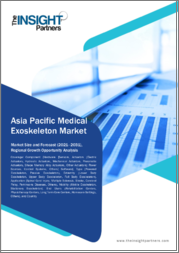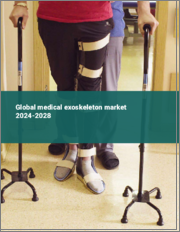
|
시장보고서
상품코드
1541057
세계의 의료용 외골격 시장 보고서 : 컴포넌트, 유형, 부위, 가동성, 최종사용자, 지역별(2024-2032년)Medical Exoskeleton Market Report by Component, Type, Extremity, Mobility, End User, and Region 2024-2032 |
||||||
의료용 외골격 시장 세계 시장 규모는 2023년 3억 7,880만 달러에 달했습니다. 향후 IMARC Group은 시장이 2032년까지 45억 860만 달러에 이르고, 2024년과 2032년 사이에 30.73%의 성장률(CAGR)을 나타낼 것으로 예측했습니다.
의료용 외골격은 재활을 위해 인간의 근골격계를 지원하는 전기 기계장치로 부상을 입거나 마비된 사람이 서거나 걸을 수 있도록 합니다. 스프링과 댐퍼의 조합을 통해 인간의 운동으로 인한 에너지를 저장하고 자세와 운동을 강화하는 데 필요한 경우 재사용 할 수 있습니다. 또한 전기, 공기, 유압 에너지를 기계적 힘으로 변환하는 액추에이터를 사용하여 인간의 움직임을 지원하고 강화합니다. 군사 분야에서는 전시 중 군인의 보호와 능력을 향상시키는 데 사용됩니다. 또한 건설 분야에서는 피로와 등, 목, 어깨 통증을 완화하는 데 사용됩니다.
의료용 외골격 시장 경향:
현재 전도, 교통사고, 폭력 등에 의한 척수손상(SCI) 증가가 시장을 견인하는 주요 요인 중 하나가 되고 있습니다. 이 외에도 세계 직원의 건강을 지원하고 생산성을 높이기 위해 다양한 산업에서 의료용 외골격 수요가 증가하고 있습니다. 이것은 외골격 기술에 익숙하고 재활을위한 솔루션을 제공하는 신흥 기업 증가와 함께 시장에 긍정적인 영향을 미칩니다. 게다가, 시장의 주요 기업은 목과 등의 문제로 고통받는 의료 종사자를 위한 항방사선 앞치마를 도입하기 위한 R&D(R&D) 활동에 자금을 제공합니다. 또한 무릎 통증을 줄이고 가동성을 되찾기 위해 착용자가 사용하는 로봇식 무릎 부분 장비의 발매에도 주력하고 있습니다. 게다가 직업성 운동과다증후군(OOS), 누적 외상장애(CTD), 반복성 긴장장애(RSI) 등 근골격계의 상해나 장애 유병률 증가가 긍정적인 시장 전망을 가져옵니다.
이 보고서에서 다루는 주요 질문
- 세계의 의료용 외골격 시장은 지금까지 어떻게 추이해, 향후 어떻게 추이해 갈 것인가?
- COVID-19는 세계 의료용 외골격 시장에 어떤 영향을 미쳤는가?
- 주요 지역 시장은?
- 컴포넌트별 시장 분석은?
- 유형별 시장 분석은?
- 부위별 시장 분석은?
- 가동성에 기초한 시장 분석은?
- 최종 사용자별 시장 분석은?
- 업계의 밸류체인의 다양한 단계란?
- 업계의 주요 촉진요인과 도전은 무엇인가?
- 세계의 의료용 외골격 시장의 구조와 주요 기업은?
- 업계 경쟁도는?
목차
제1장 서문
제2장 조사 범위와 조사 방법
- 조사의 목적
- 이해관계자
- 데이터 소스
- 1차 정보
- 2차 정보
- 시장 추정
- 상향식 접근
- 하향식 접근
- 조사 방법
제3장 주요 요약
제4장 소개
- 개요
- 주요 업계 동향
제5장 세계의 의료용 외골격 시장
- 시장 개요
- 시장 실적
- COVID-19의 영향
- 시장 예측
제6장 시장 분석 : 컴포넌트별
- 하드웨어
- 시장 동향
- 시장 예측
- 소프트웨어
- 시장 동향
- 시장 예측
제7장 시장 분석 : 유형별
- 동력형 외골격
- 시장 동향
- 시장 예측
- 패시브형 외골격
- 시장 동향
- 시장 예측
제8장 시장 분석 : 부위별
- 하지 의료용 외골격
- 시장 동향
- 시장 예측
- 상지 의료용 외골격
- 시장 동향
- 시장 예측
- 전신
- 시장 동향
- 시장 예측
제9장 시장 분석 : 가동성별
- 이동형 외골격
- 시장 동향
- 시장 예측
- 고정식 외골격
- 시장 동향
- 시장 예측
제10장 시장 내역: 최종 사용자별
- 재활센터
- 시장 동향
- 시장 예측
- 물리치료 센터
- 시장 동향
- 시장 예측
- 기타
- 시장 동향
- 시장 예측
제11장 시장 분석: 지역별
- 북미
- 미국
- 캐나다
- 아시아태평양
- 중국
- 일본
- 인도
- 한국
- 호주
- 인도네시아
- 기타
- 유럽
- 독일
- 프랑스
- 영국
- 이탈리아
- 스페인
- 러시아
- 기타
- 라틴아메리카
- 브라질
- 멕시코
- 기타
- 중동 및 아프리카
- 시장 동향
- 시장 분석 : 국가별
- 시장 예측
제12장 SWOT 분석
- 개요
- 강점
- 약점
- 기회
- 위협
제13장 밸류체인 분석
제14장 Porter's Five Forces 분석
- 개요
- 구매자의 협상력
- 공급기업의 협상력
- 경쟁도
- 신규 진입업자의 위협
- 대체품의 위협
제15장 가격 분석
제16장 경쟁 구도
- 시장 구조
- 주요 기업
- 주요 기업 프로파일
- B-Temia Inc.
- Cyberdyne Inc.
- Ekso Bionics Holdings Inc.
- ExoAtlet Global SA
- GOGOA Mobility Robots
- Hocoma AG(DIH International Limited)
- Myomo Inc.
- ReWalk Robotics Ltd
- Rex Bionics Ltd.
- suitX Inc.(Ottobock SE & Co. KGaA)
- Wandercraft
- Wearable Robotics Srl
The global medical exoskeleton market size reached US$ 378.8 Million in 2023. Looking forward, IMARC Group expects the market to reach US$ 4,508.6 Million by 2032, exhibiting a growth rate (CAGR) of 30.73% during 2024-2032.
A medical exoskeleton is an electromechanical device that supports the human musculoskeletal system for rehabilitation and enables an injured or paraplegic person to stand and walk. It relies on a combination of springs and dampers that can store energy from human motion and reuse it when required to enhance a posture or motion. It also uses actuators that convert electrical, air, or hydraulic energy into mechanical force to support and strengthen the human movement. It is employed in the military sector to give soldiers additional protection and abilities during warfare. It is also used in the construction sector to reduce fatigue and back, neck, and shoulder pain.
Medical Exoskeleton Market Trends:
At present, the growing incidences of spinal cord injuries (SCI) due to falls, road traffic crashes, or violence represent one of the key factors driving the market. Besides this, there is a rise in the demand for medical exoskeletons in various industries to support employee health and boost productivity around the world. This, along with the rising number of startups that expertise in exoskeleton technology and provide solutions for rehabilitation, is positively influencing the market. Moreover, key market players are financing research and development (R&D) activities to introduce anti-radiation aprons for health workers suffering from neck and back problems. They are also focusing on launching a robotic partial knee orthosis used by wearers to reduce knee pain and regain mobility. In addition, the growing prevalence of musculoskeletal injuries and disorders, such as occupational overuse syndrome (OOS), cumulative trauma disorders (CTD), and repetitive strain injury (RSI), is offering a positive market outlook.
Key Market Segmentation:
IMARC Group provides an analysis of the key trends in each sub-segment of the global medical exoskeleton market report, along with forecasts at the global, regional and country level from 2024-2032. Our report has categorized the market based on component, type, extremity, mobility and end user.
Breakup by Component:
Hardware
Software
Breakup by Type:
Powered Exoskeletons
Passive Exoskeletons
Breakup by Extremity:
Lower Extremity Medical Exoskeletons
Upper Extremity Medical Exoskeletons
Full Body
Breakup by Mobility:
Mobile Exoskeletons
Stationary Exoskeletons
Breakup by End User:
Rehabilitation Centers
Physiotherapy Centers
Others
Breakup by Region:
North America
United States
Canada
Asia-Pacific
China
Japan
India
South Korea
Australia
Indonesia
Others
Europe
Germany
France
United Kingdom
Italy
Spain
Russia
Others
Latin America
Brazil
Mexico
Others
Middle East and Africa
Competitive Landscape:
The competitive landscape of the industry has also been examined along with the profiles of the key players being B-Temia Inc., Cyberdyne Inc., Ekso Bionics Holdings Inc., ExoAtlet Global S.A., GOGOA Mobility Robots, Hocoma AG (DIH International Limited), Myomo Inc., ReWalk Robotics Ltd, Rex Bionics Ltd., suitX Inc. (Ottobock SE & Co. KGaA), Wandercraft and Wearable Robotics Srl.
Key Questions Answered in This Report:
- How has the global medical exoskeleton market performed so far and how will it perform in the coming years?
- What has been the impact of COVID-19 on the global medical exoskeleton market?
- What are the key regional markets?
- What is the breakup of the market based on the component?
- What is the breakup of the market based on the type?
- What is the breakup of the market based on the extremity?
- What is the breakup of the market based on the mobility?
- What is the breakup of the market based on the end user?
- What are the various stages in the value chain of the industry?
- What are the key driving factors and challenges in the industry?
- What is the structure of the global medical exoskeleton market and who are the key players?
- What is the degree of competition in the industry?
Table of Contents
1 Preface
2 Scope and Methodology
- 2.1 Objectives of the Study
- 2.2 Stakeholders
- 2.3 Data Sources
- 2.3.1 Primary Sources
- 2.3.2 Secondary Sources
- 2.4 Market Estimation
- 2.4.1 Bottom-Up Approach
- 2.4.2 Top-Down Approach
- 2.5 Forecasting Methodology
3 Executive Summary
4 Introduction
- 4.1 Overview
- 4.2 Key Industry Trends
5 Global Medical Exoskeleton Market
- 5.1 Market Overview
- 5.2 Market Performance
- 5.3 Impact of COVID-19
- 5.4 Market Forecast
6 Market Breakup by Component
- 6.1 Hardware
- 6.1.1 Market Trends
- 6.1.2 Market Forecast
- 6.2 Software
- 6.2.1 Market Trends
- 6.2.2 Market Forecast
7 Market Breakup by Type
- 7.1 Powered Exoskeletons
- 7.1.1 Market Trends
- 7.1.2 Market Forecast
- 7.2 Passive Exoskeletons
- 7.2.1 Market Trends
- 7.2.2 Market Forecast
8 Market Breakup by Extremity
- 8.1 Lower Extremity Medical Exoskeletons
- 8.1.1 Market Trends
- 8.1.2 Market Forecast
- 8.2 Upper Extremity Medical Exoskeletons
- 8.2.1 Market Trends
- 8.2.2 Market Forecast
- 8.3 Full Body
- 8.3.1 Market Trends
- 8.3.2 Market Forecast
9 Market Breakup by Mobility
- 9.1 Mobile Exoskeletons
- 9.1.1 Market Trends
- 9.1.2 Market Forecast
- 9.2 Stationary Exoskeletons
- 9.2.1 Market Trends
- 9.2.2 Market Forecast
10 Market Breakup by End User
- 10.1 Rehabilitation Centers
- 10.1.1 Market Trends
- 10.1.2 Market Forecast
- 10.2 Physiotherapy Centers
- 10.2.1 Market Trends
- 10.2.2 Market Forecast
- 10.3 Others
- 10.3.1 Market Trends
- 10.3.2 Market Forecast
11 Market Breakup by Region
- 11.1 North America
- 11.1.1 United States
- 11.1.1.1 Market Trends
- 11.1.1.2 Market Forecast
- 11.1.2 Canada
- 11.1.2.1 Market Trends
- 11.1.2.2 Market Forecast
- 11.1.1 United States
- 11.2 Asia-Pacific
- 11.2.1 China
- 11.2.1.1 Market Trends
- 11.2.1.2 Market Forecast
- 11.2.2 Japan
- 11.2.2.1 Market Trends
- 11.2.2.2 Market Forecast
- 11.2.3 India
- 11.2.3.1 Market Trends
- 11.2.3.2 Market Forecast
- 11.2.4 South Korea
- 11.2.4.1 Market Trends
- 11.2.4.2 Market Forecast
- 11.2.5 Australia
- 11.2.5.1 Market Trends
- 11.2.5.2 Market Forecast
- 11.2.6 Indonesia
- 11.2.6.1 Market Trends
- 11.2.6.2 Market Forecast
- 11.2.7 Others
- 11.2.7.1 Market Trends
- 11.2.7.2 Market Forecast
- 11.2.1 China
- 11.3 Europe
- 11.3.1 Germany
- 11.3.1.1 Market Trends
- 11.3.1.2 Market Forecast
- 11.3.2 France
- 11.3.2.1 Market Trends
- 11.3.2.2 Market Forecast
- 11.3.3 United Kingdom
- 11.3.3.1 Market Trends
- 11.3.3.2 Market Forecast
- 11.3.4 Italy
- 11.3.4.1 Market Trends
- 11.3.4.2 Market Forecast
- 11.3.5 Spain
- 11.3.5.1 Market Trends
- 11.3.5.2 Market Forecast
- 11.3.6 Russia
- 11.3.6.1 Market Trends
- 11.3.6.2 Market Forecast
- 11.3.7 Others
- 11.3.7.1 Market Trends
- 11.3.7.2 Market Forecast
- 11.3.1 Germany
- 11.4 Latin America
- 11.4.1 Brazil
- 11.4.1.1 Market Trends
- 11.4.1.2 Market Forecast
- 11.4.2 Mexico
- 11.4.2.1 Market Trends
- 11.4.2.2 Market Forecast
- 11.4.3 Others
- 11.4.3.1 Market Trends
- 11.4.3.2 Market Forecast
- 11.4.1 Brazil
- 11.5 Middle East and Africa
- 11.5.1 Market Trends
- 11.5.2 Market Breakup by Country
- 11.5.3 Market Forecast
12 SWOT Analysis
- 12.1 Overview
- 12.2 Strengths
- 12.3 Weaknesses
- 12.4 Opportunities
- 12.5 Threats
13 Value Chain Analysis
14 Porters Five Forces Analysis
- 14.1 Overview
- 14.2 Bargaining Power of Buyers
- 14.3 Bargaining Power of Suppliers
- 14.4 Degree of Competition
- 14.5 Threat of New Entrants
- 14.6 Threat of Substitutes
15 Price Analysis
16 Competitive Landscape
- 16.1 Market Structure
- 16.2 Key Players
- 16.3 Profiles of Key Players
- 16.3.1 B-Temia Inc.
- 16.3.1.1 Company Overview
- 16.3.1.2 Product Portfolio
- 16.3.2 Cyberdyne Inc.
- 16.3.2.1 Company Overview
- 16.3.2.2 Product Portfolio
- 16.3.2.3 Financials
- 16.3.3 Ekso Bionics Holdings Inc.
- 16.3.3.1 Company Overview
- 16.3.3.2 Product Portfolio
- 16.3.4 ExoAtlet Global S.A.
- 16.3.4.1 Company Overview
- 16.3.4.2 Product Portfolio
- 16.3.5 GOGOA Mobility Robots
- 16.3.5.1 Company Overview
- 16.3.5.2 Product Portfolio
- 16.3.6 Hocoma AG (DIH International Limited)
- 16.3.6.1 Company Overview
- 16.3.6.2 Product Portfolio
- 16.3.7 Myomo Inc.
- 16.3.7.1 Company Overview
- 16.3.7.2 Product Portfolio
- 16.3.7.3 Financials
- 16.3.8 ReWalk Robotics Ltd
- 16.3.8.1 Company Overview
- 16.3.8.2 Product Portfolio
- 16.3.8.3 Financials
- 16.3.9 Rex Bionics Ltd.
- 16.3.9.1 Company Overview
- 16.3.9.2 Product Portfolio
- 16.3.10 suitX Inc. (Ottobock SE & Co. KGaA)
- 16.3.10.1 Company Overview
- 16.3.10.2 Product Portfolio
- 16.3.11 Wandercraft
- 16.3.11.1 Company Overview
- 16.3.11.2 Product Portfolio
- 16.3.12 Wearable Robotics Srl
- 16.3.12.1 Company Overview
- 16.3.12.2 Product Portfolio
- 16.3.1 B-Temia Inc.



















